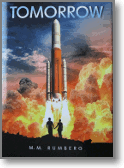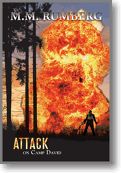
Tomorrow
Preview
Chapter 1
The Near Future
The Deep Space savior of humanity. The apocalypse was at hand.
Was it the end of the Earth? Humans had desecrated the planet through constant wars and over-population and had stripped the planet of its resources. Through the years, countless millions had been killed over issues like oil, religion, and land, with millions more displaced as refugees. Huge water shortages had greatly impacted agricultural production causing crop failure and empty and uncultivated land. Thousands upon thousands starved. Strip mining and the continual burning of fossil fuel accelerated rising CO2 levels and filled the air with pollutants. Unprecedented deforestation had altered weather patterns. Increasing acidic levels in the oceans led to extraordinary aquatic loss.
The ice caps had shrunk—and the remaining caps and glaciers were melting at an accelerating rate forcing large land areas along the shoreline underwater. An astonishing number of animal and plant species had already become extinct—a one or two degree rise in temperature destroyed them quickly—and there no longer was a reasonable way to stop future losses, let alone reverse them. And still, unbelievably, politicians still denied that global warming was occurring.
In spite of all the evidence, warnings, and lives lost, nations refused to take determined action and refused to cooperate, paying lip service to conservation efforts and treaties. No relief was in sight. The Earth‘s population had grown to over eight billion people and had become rogue animals that soiled their own nests. Now they were beginning to pay for their transgressions.
As if to further emphasize Earth‘s predicament, astronomers discovered that a huge asteroid, a massive one, almost a quarter the size of the moon, was heading Earth‘s way. At first astronomers predicted that the asteroid would hit Earth, and if so, life on Earth would cease to exist—the doomsday prediction. Subsequent calculations said it wouldn‘t directly impact the Earth but would be a near miss—a very near miss. It was hardly grounds for celebration. Because of its growing proximity, it was being called a Near Earth Object—NEO sounded much nicer than "an asteroid about to smash into and devastate the planet"—and it was beginning to cause damage to the planet. Its magnetic signature was off the charts.
Even at this distance it was having an effect on the Earth‘s tides and gravity, and was causing what scientists termed vortexes. These were atmospheric shock waves producing massively destructive weather systems that could wipe out large geographical areas. And the closer the asteroid came, the more destruction it would cause. Some astronomers thought there was a high probability, whether it hit Earth or not, that Earth had run out of alternatives.
"How can magnetic shock waves from the asteroid, with it so far away, cause these vortexes on Earth?" asked one reporter.
A NASA spokesperson, Jerome Cook, tried to explain. "They are very much like solar flares," he said. "Usually a solar flare applies to a very broad spectrum of energy release from the sun. However, similar phenomena are occurring with this asteroid. We don‘t know why."
"But solar flares don‘t usually cause trouble here on Earth, right?"
Cook shook his head. "They can, and sometimes, do. For example, the UV radiation and X-rays can disrupt radio communication, radars, and any device that uses those wavelengths. Luckily, most of the solar flares from the sun miss the Earth so we‘re largely spared any consequences."
"So, again, how does this asteroid affect the Earth? It‘s not a…wayward sun, is it?"
Cook smiled. "No, the energy release, but the mechanism, the why and when it happens, is not known."
"So, when is the next one, the next magnetic flare?"
Cook sighed. "I wish I knew. We simply are not able to predict them. The best we can do is provide a minute or two of advance notice when one is about to strike."
Later, the reporter realized he had been deluged with scientific answers that he simply could not understand. His resulting story was caustic.
"Scientists apparently don‘t have the answers. Are they hiding behind their ignorance they don‘t want to admit? All they had to say was they were unsure of what and why this was happening, but clarifying that seems not to be on their agenda. No one will even speculate what will happen if the moon and earth‘s gravitational pull conflict with the asteroid. This leaves us to wonder what NASA is doing, other than asking for more money and complaining that our satellites are being disrupted and knocked out of orbit. The only thing that is known for sure, is that this asteroid is huge, and even from its vast distance from the Earth, is already causing great damage here and it will only get worse."
Anticipating enormous devastation, NASA, in collaboration with DARPA, the Department of Defense‘s Advanced Research Projects Agency, and the European Space Agency initiated an emergency mission that might have a chance…a good one, they said…, "to ensure humanity‘s survival of the species."
They named it the "Hope of Humanity." Everyone called it "The Ark."
But if it failed….
 Other Novels and Short Stories by M.M.Rumberg:
Other Novels and Short Stories by M.M.Rumberg:










